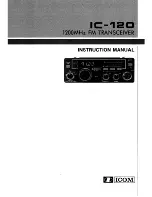
______________________________________________
HARRIS
888-9058-001
WARNING: Disconnect and lockout AC primary power prior to servicing
191
significantly. If the ISO voltage of any quarter module exceeds about 1.9 Volts, the
control board shuts the power amplifier module down and indicates an ISO fault.
An ISO fault will almost always be caused by a component failure in a quarter module
(RF FET, chip cap, ISO resistor, or open solder connection). The common cause is a
damaged RF FET.
Damaged FETs are sometimes caused by problems in the module output combiner,
examine this area first before trying to re-enable the module to avoid further damage.
With DC power and RF drive removed, visually inspect the connections between the
quarter module outputs and combiner inputs, between the combiner sections, between
the combiner output and the directional coupler, and between the coupler and the output
connector. An inspection mirror aids the examination greatly. Next, use an ohmmeter to
confirm an open between the output connector center pin and chassis, and continuity
between the center pin and each quarter module output. Also examine each quarter
module, especially the area near its output.
If no problems are found with the output circuitry, try to confirm the ISO fault with the
module on the test fixture. Put the safety cover down (applying RF drive), switch on the
DC power and attempt to enable the module. If the ISO fault does not occur again, there
may be a problem in the system rather than with the module (for example, an open
cabinet combiner dump load or a damaged module RF power input connector).
If the ISO fault is confirmed, check the bias current of each quarter module, one at a
time with no drive applied (lift the safety cover to remove RF drive). A quarter module
with bad FET(s) will have lower bias current than the others. Check the section on bias
current setting to confirm the correct bias current for each quarter module. If a quarter
module with low bias current is found, first record its total bias current, then observe the
current while turning off bias to each FET one at a time with the bias adjustment pots.
Record the current after turning each pot off and look for one or more FETs whose bias
current is zero or lower than the others.
If no quarter modules or FETs indicate low bias current, there are two possibilities:
either a shorted, open or damaged component on a quarter module, or a problem with
the PCM (logic) board. Try to rule out a problem with the PCM board first. If a storage
oscilloscope or peak-holding DMM (e.g. Fluke 87) is available, try to confirm an ISO
voltage greater than about 1.9 Volts. Remove DC power, clip a probe onto the ISO
voltage line close the safety cover, connect the probe to the scope or DMM, apply DC
and enable the module. If the ISO voltage does not appear, look for problems on the
module PCM board (check for 0.9-1.0 Volts on U6 pin 10). If no storage scope or peak-
holding DMM is available, proceed to looking for problems on the quarter modules
after checking for 0.9-1.0 Volts on U6 pin 10 of the PCM board.
















































